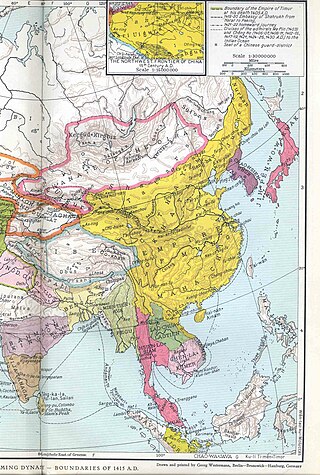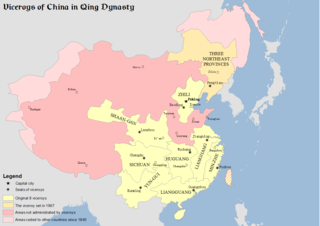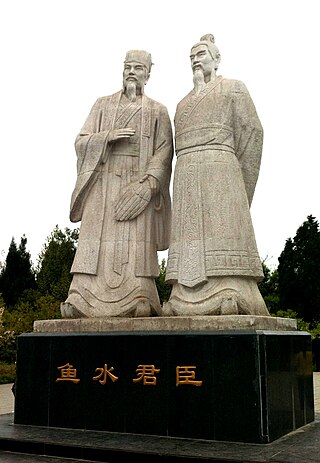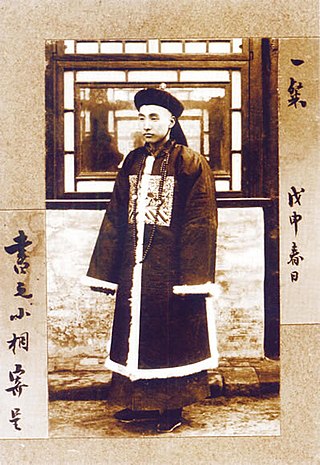Related Research Articles

The Ming dynasty,officially the Great Ming,was an imperial dynasty of China,ruling from 1368 to 1644 following the collapse of the Mongol-led Yuan dynasty. The Ming dynasty was the last imperial dynasty of China ruled by the Han people,the majority ethnic group in China. Although the primary capital of Beijing fell in 1644 to a rebellion led by Li Zicheng,numerous rump regimes ruled by remnants of the Ming imperial family—collectively called the Southern Ming—survived until 1662.

Zongdu were high-level officials responsible for overseeing the governors of several provinces in Ming and Qing China. One viceroy usually administered several provinces and was in charge of all affairs of military,food,wages,rivers,and provincial governors within their region of jurisdiction. Viceroys were appointed by and directly reported to the Emperor.

Amban is a Manchu language term meaning "high official",corresponding to a number of different official titles in the imperial government of Qing China. For instance,members of the Grand Council were called Coohai nashūn-i amban in the Manchu language and Qing governor-generals were called Uheri kadalara amban.

The grand chancellor,also translated as counselor-in-chief,chancellor,chief councillor,chief minister,imperial chancellor,lieutenant chancellor and prime minister,was the highest-ranking executive official in the imperial Chinese government. The term was known by many different names throughout Chinese history,and the exact extent of the powers associated with the position fluctuated greatly,even during a particular dynasty.
The Lifan Yuan was an agency in the government of the Qing dynasty of China which administered the empire's Inner Asian territories such as Mongolia and oversaw the appointments of Ambans in Tibet. Until the 1860s,it was also responsible for the Qing's relations with the Russian Empire.
The Zhongshu Sheng,also known as the Palace Secretariat or Central Secretariat,was one of the departments of the Three Departments and Six Ministries government structure in imperial China from the Cao Wei (220–266) until the early Ming dynasty. As one of the Three Departments,the Zhongshu Sheng was primarily a policy-formulating agency responsible for proposing and drafting all imperial decrees,but its actual function varied at different times. The department traces its origins back to the Han dynasty.
The Three Departments and Six Ministries system was the primary administrative structure in imperial China from the Sui dynasty (581–618) to the Yuan dynasty (1271–1368). It was also used by Balhae (698–926) and Goryeo (918–1392) and various other kingdoms in Manchuria,Korea and Vietnam.
The Nine Ministers or Nine Chamberlains was the collective name for nine high officials in the imperial government of the Han dynasty,who each headed one of the Nine Courts and were subordinates to the Three Councillors of State.
The Grand Secretariat,or the Cabinet,was nominally a coordinating agency but de facto the highest institution in the imperial government of the Chinese Ming dynasty. It first took shape after the Hongwu Emperor abolished the office of Chancellor in 1380 and gradually evolved into an effective coordinating organ superimposed on the Six Ministries. There were altogether six Grand Secretaries,though the posts were not always filled. The most senior one was popularly called Senior Grand Secretary. The Grand Secretaries were nominally ranked as mid-level officials,ranked much lower than the Ministers,heads of the Ministries. However,since they screened documents submitted to the emperor from all governmental agencies,and had the power of drafting suggested rescripts for the emperor,generally known as piàonǐ (票擬) or tiáozhǐ (條旨),some senior Grand Secretaries were able to dominate the whole government,acting as de facto Chancellor. The term nèigé itself is now used to refer to the modern cabinet in Chinese.
The Imperial Household Department was an institution of the Qing dynasty of China. Its primary purpose was to manage the internal affairs of the Qing imperial family and the activities of the inner palace,but it also played an important role in Qing relations with Tibet and Mongolia,engaged in trading activities,managed textile factories in the Jiangnan region,and even published books.
The Ministry or Board of Rites was one of the Six Ministries of government in late imperial China. It was part of the imperial Chinese government from the Tang until the 1911 Xinhai Revolution. Along with religious rituals and court ceremonial the Ministry of Rites also oversaw the imperial examination and China's foreign relations.
The Imperial Clan Court or Court of the Imperial Clan was an institution responsible for all matters pertaining to the imperial family under the Ming and Qing dynasties of imperial China. This institution also existed under the Nguyễn dynasty of Vietnam where it managed matters pertaining to the Nguyễn Phúc clan.
The Shangshu Sheng,sometimes translated as the Department of State Affairs or the Imperial Secretariat,was one of the departments of the Three Departments and Six Ministries government structure. It was the primary executive institution of imperial China,head of the Six Ministries,the Nine Courts,and the Three Directorates. The Six Ministries consisted of the Ministry of Personnel,the Ministry of Revenue,the Ministry of Rites,the Ministry of War,the Ministry of Justice,and the Ministry of Works. The Department of State of Affairs existed in one form or another from the Han dynasty until the Yuan dynasty (1271–1368),but was never re-established in the following Ming dynasty.
The Menxia Sheng,sometimes translated as the Chancellery,was one of the departments of the Three Departments and Six Ministries government structure of imperial China. It advised the emperor and the Zhongshu Sheng,and reviewed edicts and commands. As the least important of the three departments,it existed in name only by the Song dynasty while its functions were delegated to the other two departments. In 1129,the Chancellery was merged with the Central Secretariat.
The Bureau of Military Affairs was the central government agency in charge of a state's military forces during the Five Dynasties and Ten Kingdoms period,Liao dynasty,Song dynasty and Yuan dynasty. It was headed by the Shumishi.
The Ministry or Board of Revenue was one of the Six Ministries under the Department of State Affairs in imperial China.
The Three Bureaus traditionally refer to the Bureau of Salt and Iron Monopoly,Tax Bureau,and Census bureau that originated during the Song dynasty. However the Three Bureaus have been used to refer to different institutions at different points in Chinese history. In the Eastern Han (25-220),it included posts such as Defender-in-Chief (taiwei),Minister of Education (situ),and Minister of Works (sikong). In the Tang dynasty (618-907),it referred to the Censorate (yushitai),the Chancellery,and the Palace Secretariat. During the Ming dynasty,it referred to three provincial level institutions:the regional military commission,the Provincial Administration Commission,and the Provincial Surveillance Commission.
The political systems of Imperial China can be divided into a state administrative body,provincial administrations,and a system for official selection. The three notable tendencies in the history of Chinese politics includes,the convergence of unity,the capital priority of absolute monarchy,and the standardization of official selection. Moreover,there were early supervisory systems that were originated by local factions,as well as other political systems worthy of mention.

The administration of territory in dynastic China is the history of practices involved in governing the land from the Qin dynasty to the Qing dynasty (1644–1912).

The Qing dynasty (1644–1912) was the last imperial dynasty of China. The early Qing emperors adopted the bureaucratic structures and institutions from the preceding Ming dynasty but split rule between the Han and Manchus with some positions also given to Mongols. Like previous dynasties,the Qing recruited officials via the imperial examination system until the system was abolished in 1905. The Qing divided the positions into civil and military positions,each having nine grades or ranks,each subdivided into a and b categories. Civil appointments ranged from an attendant to the emperor or a grand secretary in the Forbidden City (highest) to being a prefectural tax collector,deputy jail warden,deputy police commissioner,or tax examiner. Military appointments ranged from being a field marshal or chamberlain of the imperial bodyguard to a third class sergeant,corporal or a first or second class private.
References
Citations
- 1 2 3 Hucker (1985), p. 294.
- ↑ Hucker (1985), p. 245.
- ↑ Hucker (1985), p. 427.
- 1 2 Hucker (1958), p. 32.
Sources
- Hucker, Charles O. (1958), "Governmental Organization of The Ming Dynasty", Harvard Journal of Asiatic Studies, 21: 1–66, doi:10.2307/2718619, JSTOR 2718619.
- Hucker, Charles O. (1985). A Dictionary of Official Titles in Imperial China. Stanford University Press. ISBN 9576382858.